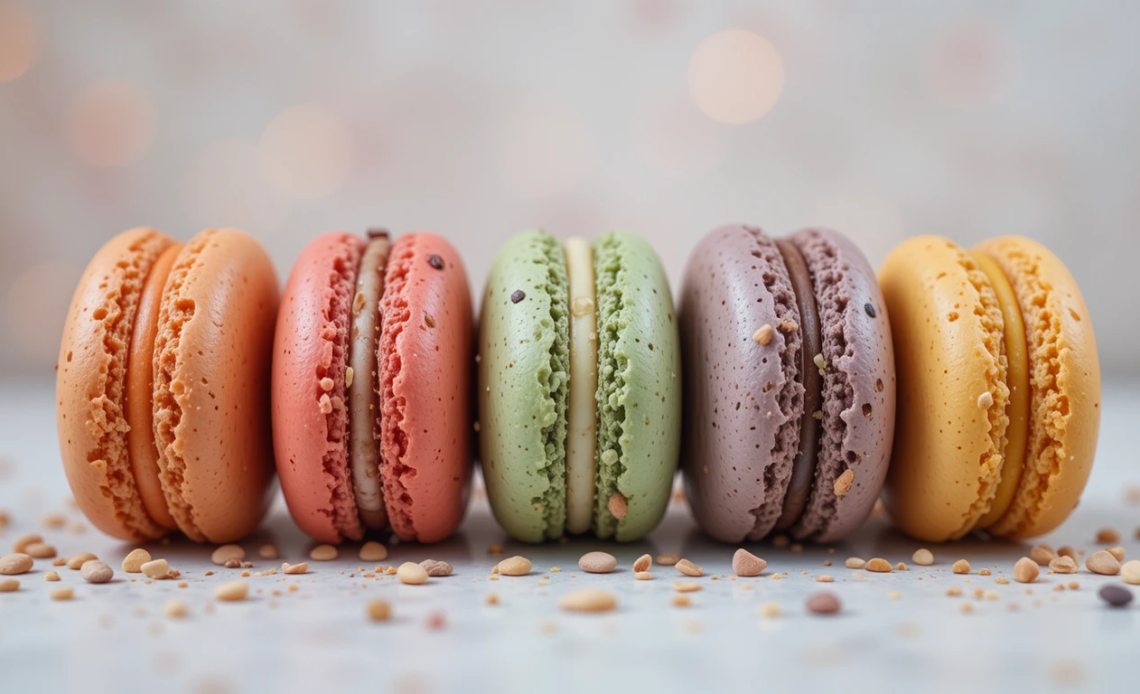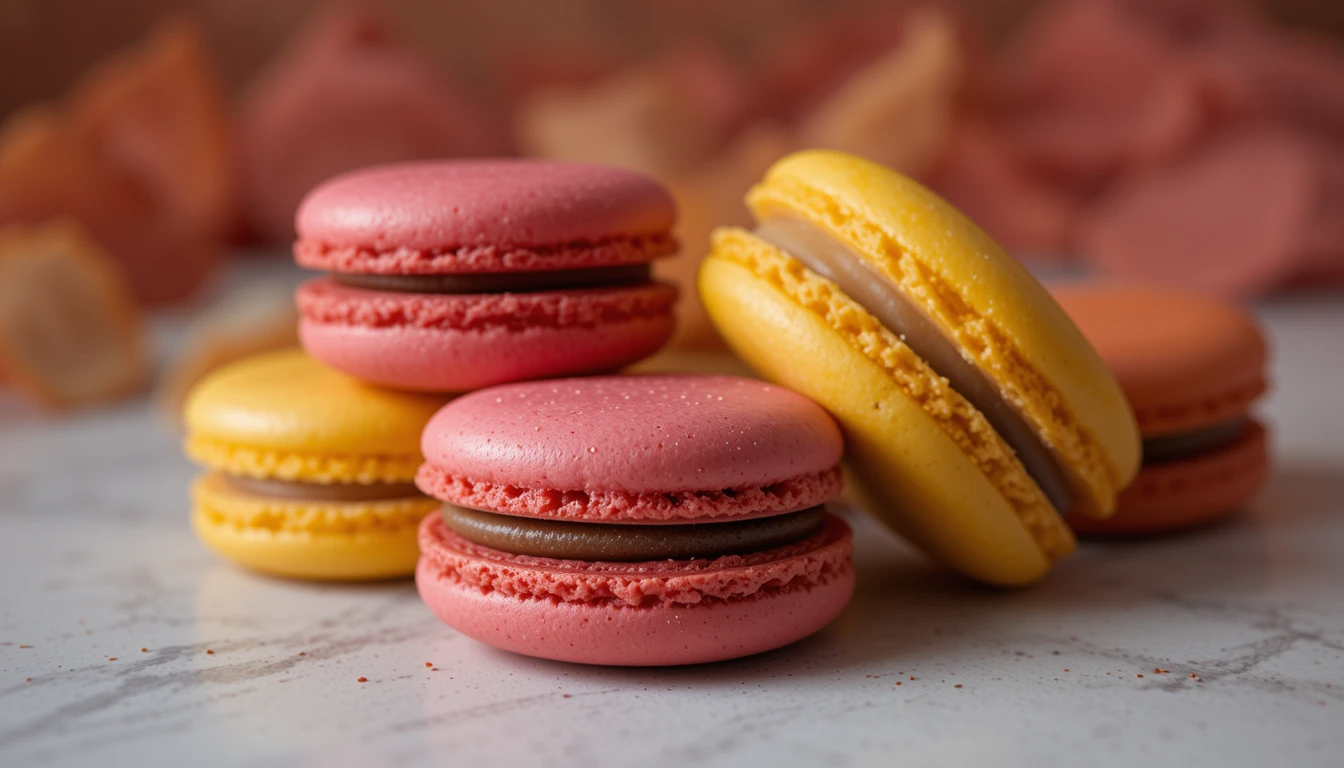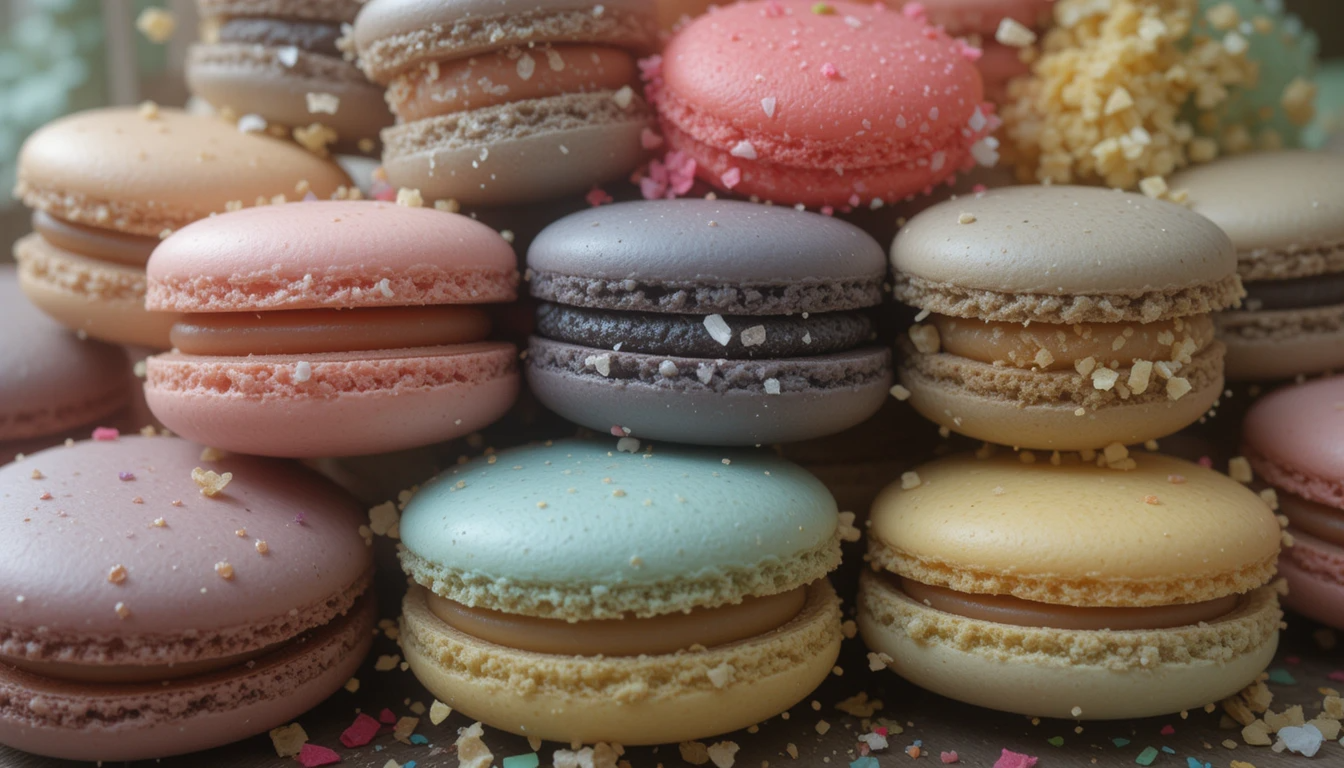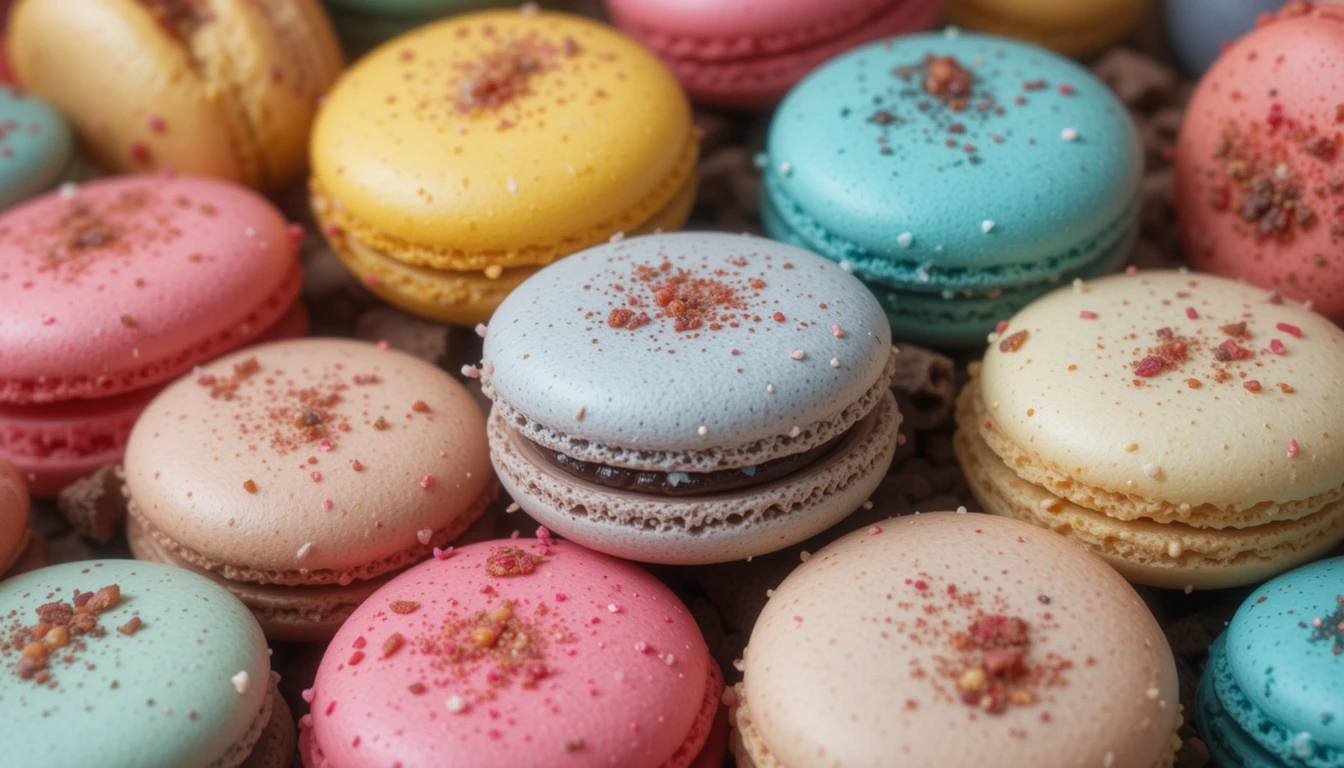
Macarons are delicate meringue-based sandwich cookies that have captured dessert lovers’ hearts worldwide. They typically feature a crisp, airy shell and a luscious ganache, buttercream, or jam filling. Their iconic smooth surface and vibrant colors make macarons a visual and gastronomic delight, steeped in centuries of French tradition.
Table of Contents
Introduction
If you’ve ever strolled past a French bakery window and felt your heart skip a beat at the sight of perfectly rounded, pastel-hued treats, you’ve experienced the enchanting pull of macarons. Whether it was love at first bite or you’ve merely admired them from afar, macarons have a special power to captivate the senses. Perhaps it’s the way each shell shines ever so slightly, hinting at the crisp exterior waiting to give way to a chewy almond center. Or maybe it’s the swirl of flavors—berries, chocolate, matcha, salted caramel—nestled between the delicate halves. Regardless, there’s something undeniably magical about these airy confections.
Yet, behind their sweet façade and playful colors lies a depth of history, technique, and even heated debate. Where did macarons come from? How exactly do you master their notoriously tricky preparation? And why do some versions look so different from others, even though the word “macaron” is tossed around so freely? By the end of this in-depth exploration, you’ll not only understand why people go to great lengths to perfect these dainty treats, but you’ll also discover tips and insights to elevate your own macaron-making skills. After all, making macarons at home may be challenging, but it’s also immensely rewarding—and a testament to your culinary prowess.
Throughout this article, you’ll learn about the origins of macarons, how to create them flawlessly in your kitchen, and why they’re considered a showstopper at everything from afternoon tea parties to wedding dessert tables. Along the way, we’ll draw on expert references and real-life experiences. Keep in mind, this article is for informational purposes only and does not replace professional veterinary advice—yes, that may sound odd, but disclaimers are crucial whenever we discuss topics that can indirectly affect lifestyle or health decisions. So, with that said, let’s immerse ourselves in the art of macarons and uncover what makes these petite pastries so universally adored.
The History of Macarons

One of the questions dessert enthusiasts most frequently ask is: How long have macarons been around? Surprisingly, the lifespan of these confections spans centuries. Far from a fleeting culinary trend, macarons have stood the test of time, weaving themselves into French culture and beyond. Understanding their origins offers a fresh perspective on why they remain a treasured treat today.
The Early Beginnings
Though closely associated with France, the earliest form of what we now call macarons has roots in Italy. Some historians and culinary experts, such as those from the Le Cordon Bleu institution, suggest that these cookies trace back to Venetian monasteries in the Middle Ages. Legend has it that Catherine de’ Medici introduced a form of almond-based cookie to the French court upon marrying Henry II in the 16th century. Over time, that simple almond cookie began evolving into today’s sophisticated macaron.
However, back then, macarons were single-layered almond meringue cookies without the distinctive filling we associate with modern versions. They weren’t necessarily the colorful, dainty bites we love now. According to Michelin Guide historians, it was only in the early 20th century that Pierre Desfontaines, a relative of Ladurée founder Louis Ernest Ladurée, decided to sandwich two cookies together with a ganache or buttercream. The rest, as they say, is delicious history.
Evolution of Flavors
Originally, macarons had just a hint of almond flavor, showcasing the natural essence of almonds combined with sugar and egg whites. As French patisseries gained renown and competition grew fiercer, bakers began experimenting with fillings and colors. By the mid-20th century, macarons had blossomed into an array of rainbow hues—lavender, pistachio green, strawberry pink, chocolate brown, and so many more.
This evolution paralleled shifts in culinary tastes and the availability of more exotic ingredients. Fruit purées, chocolate ganache, salted caramel, and even savory infusions like foie gras began appearing in macaron filling recipes. Though the most traditional iteration remains vanilla, raspberry, and chocolate, you’ll find that the global obsession with macarons has sparked countless variations. Today, you might stumble upon bold combinations like matcha and yuzu or unexpected experiments like bacon-topped macarons. The creative possibilities seem endless, yet at their core, macarons still cherish that airy almond foundation that made them famous centuries ago.
The Art and Science of Making Macarons

Constructing the perfect macaron shell is not just about mixing ingredients; it’s about understanding the science behind each step. Professional pastry chefs can attest that macarons are as temperamental as they are gorgeous. Even slight deviations in temperature or technique can cause cracks, hollow shells, or a lack of that coveted “foot”—the ruffled edge around the base of a well-baked macaron. Don’t let these potential pitfalls scare you off; armed with the right knowledge, you’ll find making macarons at home entirely achievable.
Key Ingredients and Their Roles
- Almond Flour: This is where the signature flavor and texture of macarons originate. Finely ground almonds give macarons their nutty taste, chewy center, and structure. Always use high-quality, blanched almond flour for the best results.
- Egg Whites: Beaten into a meringue, egg whites provide the puff and crisp exterior. Fresh eggs versus aged egg whites can alter how the batter behaves. Some bakers swear by aging egg whites (leaving them uncovered in the fridge) for 24–48 hours.
- Sugar: Macarons often use both granulated sugar (mixed into egg whites) and powdered sugar (mixed with almond flour). Powdered sugar ensures a smoother shell, while the granulated sugar stabilizes the whipped egg whites.
- Flavorings and Colorings: While not strictly necessary, these transform plain shells into vibrant, unique macarons. Use gel or powder colors instead of liquid to maintain the batter’s consistency.
Crucial Techniques
- Proper Meringue Preparation: Whipping egg whites to soft peaks before gradually adding sugar is essential. Over-whipping can lead to a dry mixture, while under-whipping produces weak shells.
- Macaronage: This is the process of folding the almond flour mixture into the meringue. The key is to ensure the batter flows in a thick ribbon when lifted. Too few folds result in lumpy batter; too many lead to overly runny batter.
- Resting (Drying) the Shells: After piping, let the shells sit out until they form a thin “skin” on the surface. This allows for the formation of the iconic macaron foot. Skipping or rushing this step may cause cracks on top.
- Oven Temperature: Each oven is different. Professional pastry kitchens often rely on convection ovens that distribute heat evenly. Home bakers might need to experiment with temperature settings to find the sweet spot—usually between 300°F (150°C) and 325°F (160°C).
Common Flavor Pairings and Filling Options
The variety of flavors in macarons can be dazzling, making them an exciting dessert canvas. From classic notes of vanilla and chocolate to adventurous mixes like strawberry-basil or coconut-lime, there’s a macaron flavor for just about every palate. Below is a quick reference table to spark your imagination and help you decide which flavors to try at home or order next time.
| Flavor Shell | Recommended Filling Options | Taste Profile |
|---|---|---|
| Vanilla | Vanilla bean buttercream, white chocolate ganache | Delicate, sweet, and creamy |
| Chocolate | Dark chocolate ganache, chocolate hazelnut spread | Rich, intense, and decadent |
| Pistachio | Pistachio buttercream, pastry cream | Nutty, subtle sweetness |
| Raspberry | Raspberry jam, berry-infused buttercream | Tart, fruity burst |
| Salted Caramel | Salted caramel buttercream, caramel sauce | Sweet caramel with a salty punch |
| Matcha (Green Tea) | Matcha-infused ganache, white chocolate ganache | Earthy, slightly bitter |
| Lemon | Lemon curd, lemon buttercream | Tangy, fresh, and zesty |
| Lavender | Lavender-infused ganache, white chocolate buttercream | Floral, aromatic, calming |
The possibilities are nearly endless. When pairing flavors, think about balance—acidity from fruit purées can cut through the sweetness of the shells, while rich ganache fillings can complement lighter-flavored shells. Regardless of the flavor, do not forget the star attraction: these are still macarons, and the delicate almond profile should shine through rather than be overwhelmed by overly intense fillings.
Common Mistakes and Troubleshooting
Despite their glamorous appearance, macarons often humble even experienced bakers. If you’ve ever wondered why your macarons have cracks, no feet, or a hollow center, you’re not alone. Let’s explore common mishaps and how to fix them:
- Cracked Tops: This usually happens when the shells haven’t dried long enough, or the oven temperature is too high. Lower the heat slightly, and be patient during the drying phase.
- No Feet: Macarons without feet might be due to under-mixing your batter or skipping that critical resting period. Ensure you fold the batter enough times to achieve the right consistency and let them dry completely before baking.
- Hollow Shells: Often related to oven temperature fluctuations or over-whipped meringue. Consider checking your oven with an external thermometer, or reduce the whipping speed once you reach medium peaks in the meringue.
- Sticky Bottoms: If the macarons stick to the parchment paper or silicone mat, they might be under-baked. Another possibility is that the batter was too moist.
If you find yourself repeatedly struggling, keep a small baking journal. Jot down the temperature you used, how many minutes you mixed, and the humidity level in your kitchen. Minor tweaks can lead to major improvements.
Why Macarons Are Special in Culinary Culture

It’s no secret that macarons command a higher price tag than your average cookie, but why? Part of it is the labor-intensive process, but also the sense of luxury associated with them. In France, top patisseries treat macarons as couture confections, showcasing them in elaborate window displays and packaging them in elegant boxes. Many dessert enthusiasts equate biting into a perfectly made macaron with indulging in a piece of edible art.
From a global standpoint, macarons serve as cultural ambassadors for French pastry arts. Tourists flock to Ladurée or Pierre Hermé boutiques in Paris, often snapping photos before savoring each bite. Meanwhile, local pastry shops across the world have adapted the French techniques, fueling a universal craze. Some have even begun pairing macarons with local ingredients—think mango in tropical regions or chai spices in India—demonstrating the dessert’s adaptability and cross-cultural charm.
Beyond the aesthetic, though, there’s a sense of achievement and delight in presenting a tray of homemade macarons to family and friends. It’s a testament to patience, attention to detail, and a flair for flavor harmony. The moment you see that ruffled foot or swirl your spatula through a shiny, perfectly ribboning batter, you understand why macarons transcend mere cookies. They symbolize both artistry and tradition—a rare combination that few desserts can claim.
Health Considerations and Disclaimers
Given their sweet nature, macarons are definitely treats to enjoy in moderation. Each macaron shell typically contains sugar, and the fillings often add more sugar or fat. While indulging in a couple of macarons at a social gathering may be perfectly fine for most individuals, those with dietary restrictions—such as people with diabetes or gluten sensitivities—should consult professional medical advice before making them a regular snack.
Furthermore, some people may have allergies to nuts or specific flavorings used in macarons. Always check ingredient lists or ask your baker about possible cross-contamination if you have severe allergies. Remember: this article is for informational purposes only and does not replace professional veterinary advice or medical guidance. While macarons can be part of a joyful occasion, personal health considerations should always be a priority.
Fun and Practical Ways to Serve Macarons
There’s no denying that macarons can elevate any event—or even a casual brunch at home. Here are a few playful suggestions for incorporating these dainty confections into various occasions:
- Wedding Favors: A small box of pastel macarons can be a delightful thank-you gift for guests.
- Afternoon Tea: Pair them with classic teas like Earl Grey or green tea to complement the almond flavor.
- Dessert Buffets: Arrange macarons in rainbow tiers or color-coordinate them for festive impact.
- Gifting: Homemade macarons in a decorative tin add a personal touch to any holiday or birthday celebration.
- Photo Shoots: Their vibrant colors and picturesque shape make macarons a star on social media platforms like Instagram.
When hosting a party, consider placing macarons at the center of your dessert table. Not only do they offer a unique taste, but they also serve as an interactive conversation starter—guests love sampling different flavors and comparing notes.
FAQs
1) What is the origin of macarons?
Macarons are believed to have originated in Italy and were later popularized in France. Macarons have been beloved for centuries thanks to their delicate almond meringue structure. Macarons became the modern version we know when bakers began sandwiching them with sweet fillings.
2) Which macarons are considered the best?
Macarons from famous French patisseries like Ladurée and Pierre Hermé are often deemed the gold standard. Macarons also vary by region and baker expertise, so the “best” can be subjective. Macarons that have well-balanced flavors and consistent texture usually win top praise.
3) What do you put inside macarons?
Macarons can be filled with buttercream, ganache, jam, or even inventive creations like fruit curds. Macarons rely on a sweet component to complement their almond shells. Macarons can also feature salty or savory spins, but sweet fillings remain most traditional.
4) Which are the authentic macarons?
Macarons must have almond-based shells, a delicate crisp exterior, and a tender interior. Macarons show authenticity by forming distinct “feet” and a smooth top. Macarons without these features may be labeled as such but don’t meet the classic French criteria.
Conclusion
Macarons have journeyed from medieval monasteries to modern patisserie showcases, consistently enchanting dessert lovers along the way. Their legacy runs deeper than rainbow-colored shells and photogenic aesthetics; macarons exemplify the delicate balance of art, science, and tradition in baking. Whether you’re a kitchen novice taking on a new challenge or a seasoned pastry aficionado, the pursuit of perfect macarons is a delightful (and delicious) adventure.
Feel free to share your macaron-making experiences or favorite flavors in the comments. There’s a whole world of macaron creativity waiting for you to explore, and your personal spin might just inspire someone else to pick up a whisk. Who knows? Maybe you’ll be the one to create the next iconic flavor that wins hearts around the globe.
Key Takeaways
- Macarons originated in Italy but thrived in France, evolving into a beloved culinary staple.
- Macarons require precise technique, from proper meringue whipping to resting the shells.
- Macarons come in endless flavor combinations, making them a favorite canvas for pastry innovation.
- Macarons can be tricky, but the payoff is well worth the effort—and the world agrees!
- Macarons should be enjoyed in moderation, especially for those with dietary restrictions.
For further reading on the history of French pastries and confections, you may check out BBC Food’s comprehensive guides for additional authoritative insights.
